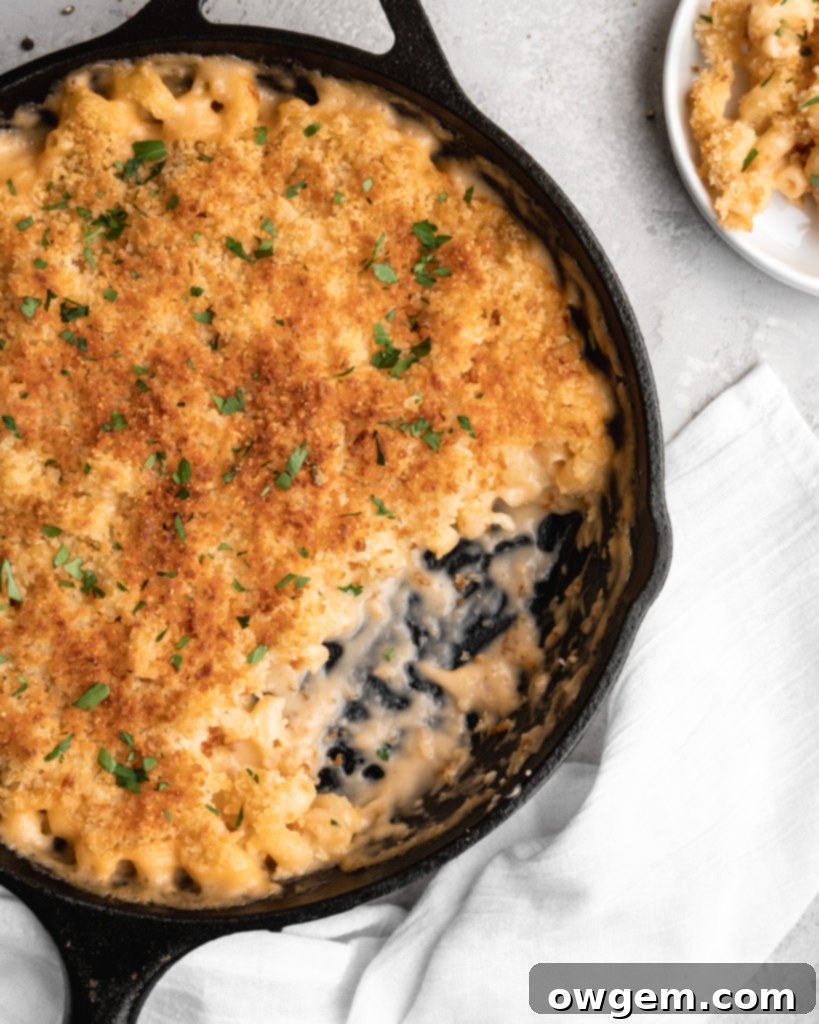The Ultimate Baked Beer Mac and Cheese Recipe: Creamy, Cheesy, and Irresistibly Flavorful
Indulge in the ultimate comfort food experience with this extraordinary Baked Beer Mac and Cheese. This dish elevates a beloved classic by infusing a rich, velvety cheese sauce with a subtly malty, yeasty pale lager, creating a depth of flavor that’s both sophisticated and incredibly satisfying. We combine the robust, distinctive notes of aged cheddar and nutty Gruyère, alongside the superb melting qualities of mozzarella, to form a harmonious blend of cheeses. To crown this culinary masterpiece, a crispy, golden Parmesan panko topping adds a delightful crunch, perfectly complementing the creamy interior. Get ready to transform your perception of macaroni and cheese with this irresistible, crowd-pleasing recipe.
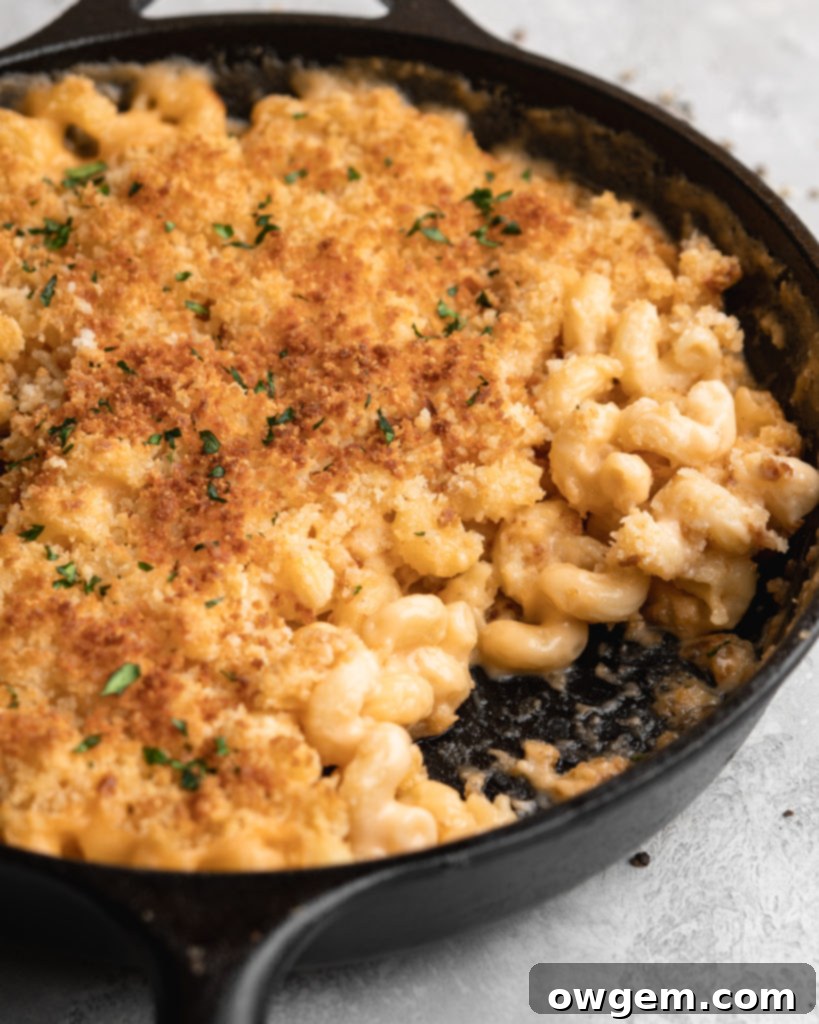
Crafting the Perfect, Silky Smooth Cheese Sauce
If you’ve ever faced the disappointment of a grainy, separated, or lackluster mac and cheese sauce, this section is your guide to achieving perfection. A truly outstanding cheese sauce forms the heart of any great mac and cheese, and with a few simple techniques, you can ensure yours is consistently smooth, creamy, and utterly delicious.
The foundation of our cheese sauce is a classic béchamel, which begins with a roux. A roux is a mixture of cooked butter and flour, acting as a thickening agent. Once your roux is ready, the key to preventing lumps and ensuring a silky texture is the slow and gradual addition of liquids. This recipe calls for both milk and beer, which should be poured into the roux incrementally while whisking continuously. This steady whisking helps to evenly disperse the flour, preventing it from clumping and forming undesirable lumps. The result is a perfectly smooth béchamel sauce, ready to be transformed into a rich cheese sauce.
After all the liquid (milk and beer) has been fully incorporated into the roux and whisked until smooth, continue cooking the béchamel over medium-low heat for 2-3 minutes. During this time, the sauce will thicken. You’ll know it’s ready when it’s thick enough to coat the back of a spoon – a consistency often referred to as nappe consistency. This is similar to the texture of full-fat buttermilk, where the sauce clings to the spoon without running off immediately. This stage is crucial for ensuring your sauce has the right body to beautifully coat your pasta.
Once your béchamel has reached the desired nappe consistency, immediately remove it from the heat. This step is paramount. Now, add all your shredded cheeses (cheddar, Gruyère, and mozzarella) into the hot béchamel at once. It is crucial NOT to return the sauce back to the heat after adding the cheese. The residual heat from the hot béchamel sauce is sufficient to melt the cheeses slowly and gently. Returning the sauce to direct heat is often the primary culprit behind a grainy, oily, or separated cheese sauce, as high heat can cause the milk proteins in the cheese to seize and curdle. Adding all the cheese at once also helps them melt evenly and combine harmoniously, creating a luxurious, cohesive cheese sauce that’s ready to coat every noodle.
Selecting the Perfect Beer for Your Mac and Cheese
The choice of beer is a defining factor in our Beer Mac and Cheese, imparting a distinct yet subtle flavor profile. My absolute preferred type of beer for this dish is a Pale or Blonde Lager, and there are several compelling reasons for this recommendation:
Firstly, **convenience and accessibility**. Pale and Blonde Lagers are incredibly common, widely available in most grocery stores and liquor shops, and typically quite affordable. This makes the recipe easy to replicate without needing to hunt for obscure ingredients.
Secondly, and most importantly, **their flavor profile**. These lagers are characterized by their mellow, clean, and often slightly malty taste, without being overwhelmingly hoppy or bitter. Their mildness ensures that the beer enhances, rather than overpowers, the rich cheese flavors. A bitter beer would introduce an undesirable astringency to the sauce, while a heavily hopped IPA, for instance, could result in a medicinal or overly floral taste that clashes with the creamy, savory cheese. Pale Lagers contribute a hint of yeasty complexity and a subtle sweetness that pairs wonderfully with the dairy notes of the cheese.
Lastly, they tend to be **lower in alcohol content** compared to many other beer styles. While much of the alcohol cooks off during the heating process, using a lower ABV beer can help ensure a smoother, less boozy flavor, allowing the malt and yeast notes to shine through without any harsh alcoholic edge.
That being said, you generally have some flexibility. Most lager-style beers will work well, as they typically share that clean, less aggressive flavor profile. Blonde ales are also a great alternative, as they often exhibit similar characteristics to lagers, offering a light, approachable taste. As a general rule of thumb, it’s wise to **use a beer you enjoy drinking**. The flavor of the beer will definitely come through in the finished sauce, so choose something you find palatable. Avoid anything too dark, too hoppy, or too sour, as these characteristics might not translate well into a creamy cheese sauce. The goal is a harmonious balance where the beer adds depth and character, rather than taking over the spotlight.
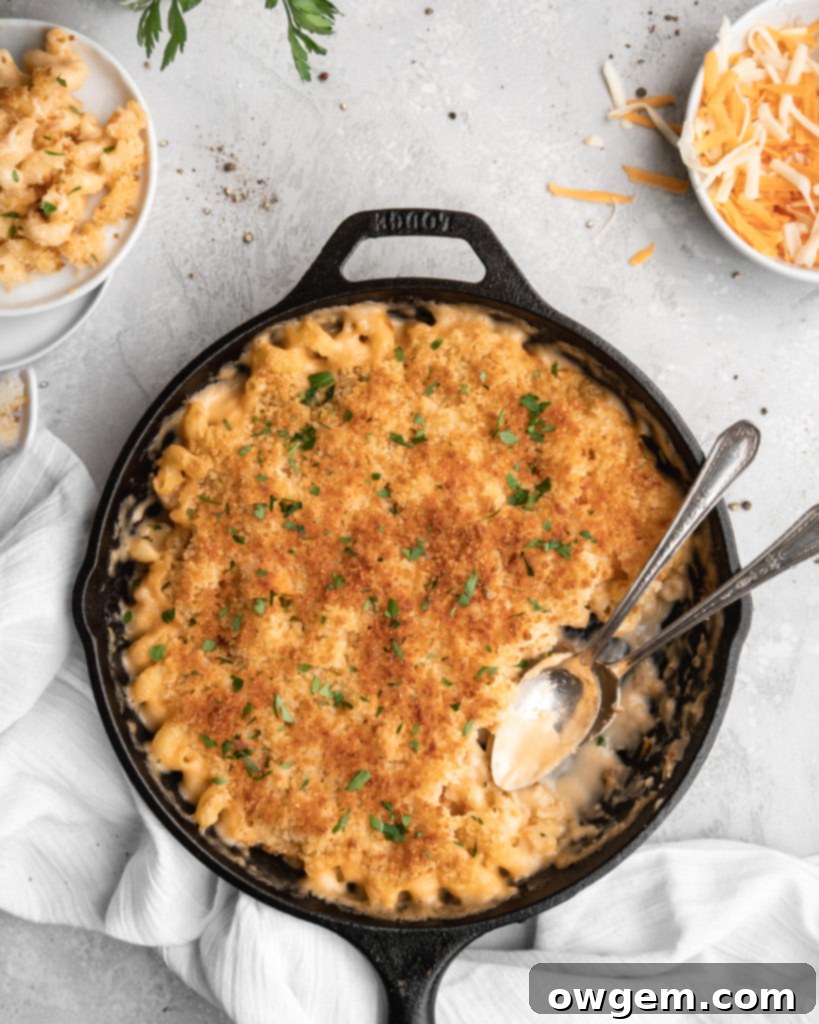
Step-by-Step Guide to Making the Beer Mac and Cheese
Crafting this delicious Baked Beer Mac and Cheese is straightforward with these detailed steps. Each stage is designed to build layers of flavor and texture, leading to an incredibly satisfying dish.
1. Prepare the Panko Topping: In a small bowl, combine the melted unsalted butter, crispy panko breadcrumbs, and finely grated Parmesan cheese. Toss everything together until the panko is thoroughly coated. This mixture will become your golden, crunchy topping, providing a delightful contrast to the creamy pasta. Set this bowl aside for later.
2. Cook the Macaroni: Bring a large pot of generously salted water to a rolling boil over high heat. Add your chosen macaroni or cavatappi pasta. Cook the macaroni according to the package instructions, but aim for **one minute less** than the recommended cooking time. This ensures the pasta remains slightly al dente, allowing it to finish cooking in the oven without becoming mushy.
3. Prepare the Roux: While your macaroni is cooking, begin making the roux. In a medium saucepan, melt the unsalted butter over medium heat. Once the butter has fully melted and just begins to bubble, sprinkle in the all-purpose flour. Whisk vigorously and continuously to combine the butter and flour, forming a smooth paste. Cook the roux for about 1-2 minutes, or until it just begins to bubble and turns a very light golden color. This cooks out the raw flour taste.
4. Incorporate Milk and Beer: With the roux ready, gradually pour in the whole milk and pale lager, a little at a time, while continuously whisking the mixture. This slow addition and constant whisking are crucial for preventing lumps and ensuring a perfectly smooth béchamel. Once all the liquid is added and well-combined, continue cooking the mixture (béchamel) over medium-low heat. Keep whisking gently until it begins to bubble and has thickened to that nappe consistency—coating the back of a spoon. This typically takes about 3-4 minutes.
5. Melt the Cheese: Immediately remove the thickened béchamel from the heat. Add all your shredded cheeses—sharp cheddar, Gruyère, and mozzarella—into the hot sauce at once. Stir lightly with a spatula or wooden spoon to submerge the cheese. Allow the cheeses to melt slowly and gently in the residual heat from the béchamel sauce. This process should take approximately 3 minutes, resulting in a perfectly smooth, unseparated cheese sauce. Once all the cheese has melted, give the sauce a good, thorough stir to evenly distribute the glorious cheesy goodness throughout.
6. Combine Sauce and Macaroni: Drain your cooked macaroni thoroughly. Transfer the pasta to a 9-inch cast iron skillet or a comparable rectangular baking dish. Pour the rich, creamy cheese sauce over the macaroni. Gently fold the noodles and sauce together using a spatula until every single noodle is beautifully and generously coated in the decadent cheese sauce.
7. Top and Bake: Evenly sprinkle the prepared Parmesan panko topping across the entire surface of the beer macaroni and cheese in the baking dish. Carefully transfer the dish into your preheated oven. Bake for approximately 25 minutes, or until the cheese sauce is bubbling enticingly around the edges and the panko topping has achieved a beautiful golden-brown crispness. The aroma alone will be enough to make your mouth water!
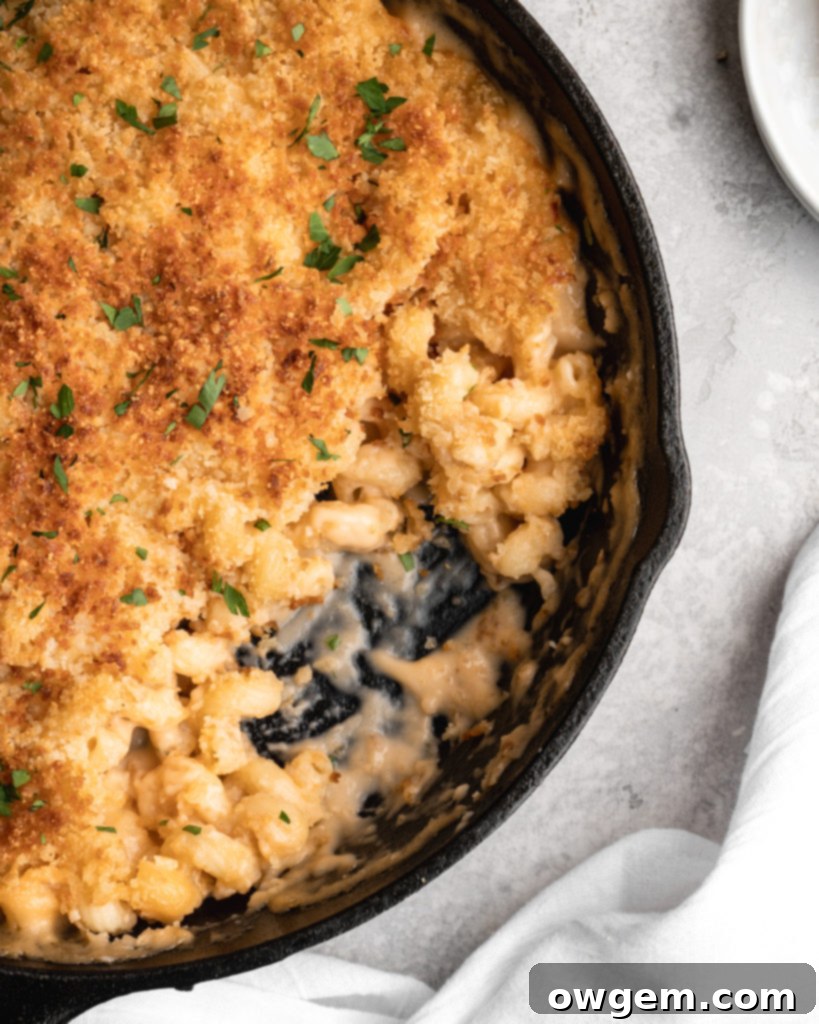
Substitutions & Variations to Customize Your Dish
This Beer Mac and Cheese recipe is wonderfully adaptable, allowing for various substitutions and creative additions to suit your preferences or what you have on hand.
• **Stovetop Version:** If you prefer not to bake your mac and cheese, or are short on time, this recipe can easily be converted into a delicious stovetop version. Simply increase the amount of noodles to 12 oz. The additional pasta will help absorb the sauce, resulting in a perfect consistency for immediate serving directly from the pot. Follow all sauce-making steps, then simply combine with the cooked pasta and serve hot.
◦ **Cheese Substitutions:** The beauty of mac and cheese lies in its versatility with cheese. While our combination of old cheddar, Gruyère, and mozzarella offers a perfect balance of flavor and melt, feel free to experiment. The key is to maintain a balance between strong, flavorful cheeses and good melting cheeses. For the strong cheese component (like cheddar and Gruyère), consider alternatives such as sharp provolone, aged gouda, or even a robust fontina for a different depth of flavor. For the melting cheese (like mozzarella), excellent substitutes include Monterey Jack, mild provolone, or a good quality Havarti. Just ensure that the combined cheeses offer both character and excellent meltability for that signature creamy texture.
• **Add-Ins for Extra Flavor:** Take your mac and cheese to the next level with delicious mix-ins. Crispy bacon bits, caramelized onions, sautéed mushrooms, or even roasted jalapeños can add fantastic layers of flavor and texture. For a heartier meal, consider stirring in shredded chicken, pulled pork, or spicy sausage. A dash of hot sauce or a pinch of smoked paprika can also introduce a wonderful kick and smoky undertone.
• **Herb and Spice Enhancements:** Beyond salt and pepper, consider incorporating other seasonings into your cheese sauce. A teaspoon of dry mustard powder can subtly enhance the cheese flavor without being overtly mustardy. Garlic powder, onion powder, or a hint of nutmeg (a classic béchamel pairing) can also round out the flavor profile beautifully. Freshly chopped chives or parsley sprinkled on top before serving add a fresh, aromatic finish.
• **Exploring Different Beer Styles:** While pale lagers are recommended for their mildness, adventurous cooks might consider other light beer styles. A crisp pilsner offers a similar clean profile. For a slightly fruitier note, a wheat beer could be interesting, but proceed with caution to ensure it doesn’t clash with the cheese. Generally, avoid very dark stouts, IPAs, or sour beers, as their intense flavors can easily overwhelm or clash with the delicate balance of the cheese sauce. However, if you’re a fan of strong flavors, a small amount of a very mild brown ale might add a touch of nutty sweetness. Remember, the goal is enhancement, not dominance.
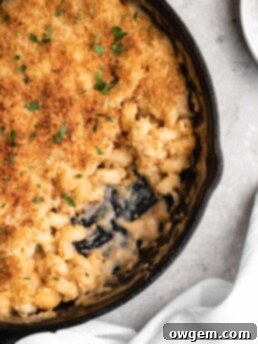
Get the Recipe:
Baked Beer Mac and Cheese
Pin
Rate
Ingredients
- 2/3 cup Panko Breadcrumbs
- 2 tbsp Unsalted Butter,, melted for topping
- 2 tbsp Very Finely Grated Parmesan Cheese
- 8 oz Elbow Macaroni or Cavatappi pasta
- 1/4 cup Unsalted Butter, for roux
- 1/3 cup All-Purpose Flour
- 1 ½ cup Whole Milk
- 1 cup Pale Lager (or Blonde Ale)
- 1 cup Shredded Sharp Cheddar Cheese
- 1 cup Shredded Gruyère Cheese
- 1 cup Shredded Mozzarella Cheese
Instructions
-
Preheat your oven to 350°F (175°C). In a small bowl, combine the 2/3 cup panko breadcrumbs, 2 tablespoons melted butter, and 2 tablespoons grated Parmesan cheese. Stir thoroughly until the panko is well-coated. Set this mixture aside.
-
Bring a large pot of generously salted water to a boil over high heat. Add the 8 oz macaroni (or cavatappi) and reduce heat to medium-high. Cook the pasta according to the box instructions, aiming for **one minute less** than the typical al dente time. This will prevent overcooking in the oven.
-
Meanwhile, in a medium saucepan, melt 1/4 cup unsalted butter over medium heat. Once the butter has melted and just begins to bubble, add the 1/3 cup all-purpose flour. Whisk continuously for 1-2 minutes to combine and cook out the raw flour taste, forming a roux. Once the roux begins to bubble, slowly pour in the 1 ½ cups whole milk and 1 cup pale lager, whisking constantly as you pour to prevent lumps.
-
After all the milk and beer has been added and fully incorporated, continue to heat the béchamel mixture over medium-low heat, whisking continuously. Heat the béchamel until it begins to bubble gently and has thickened to the consistency of full-fat buttermilk, coating the back of a spoon (nappe consistency). Remove the saucepan from the heat immediately. Add all the shredded cheeses (cheddar, Gruyère, mozzarella) and stir lightly. Set aside and let the residual heat melt the cheese.
-
After about 3 minutes, or once all the cheese has melted, stir the cheese sauce vigorously to ensure everything is evenly combined and smooth. Drain the cooked macaroni thoroughly. Add the macaroni and the finished cheese sauce to a 9-inch cast iron skillet or a rectangular baking dish. Gently fold the noodles and sauce together until every noodle is thoroughly coated.
-
Sprinkle the prepared panko topping evenly over the entire surface of the mac and cheese. Place the dish into the preheated oven and bake for 25 minutes, or until the panko topping is beautifully golden brown and crispy, and the cheese sauce is bubbling around the edges. Serve hot and enjoy!


